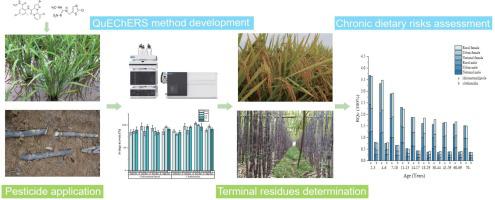Microchemical Journal ( IF 4.9 ) Pub Date : 2022-09-09 , DOI: 10.1016/j.microc.2022.107936 Chuanying Cheng , Jiye Hu

|
To determine the residue levels of chlorantraniliprole and clothianidin in rice and sugar cane and to assess the corresponding chronic dietary risk, field trials and analyses of chlorantraniliprole and clothianidin in rice and sugar cane were conducted in 2019 in China. A QuEChERS method combined with high-performance liquid chromatography coupled with tandem mass spectrometry (HPLC–MS/MS) was developed for the simultaneous determination of these two compounds in rice and sugar cane, and field samples, including brown rice, rice husk and straw from 12 rice field trials and sugar cane from 6 field trials, were further analysed. The highest residue levels of chlorantraniliprole were 0.01 mg kg−1 in brown rice and 0.12 mg kg−1 in paddy rice at harvest time, and the highest residue levels of clothianidin reached 0.01 and 0.02 mg kg−1. The highest residue levels of these two pesticides in sugar cane were no higher than 0.01 mg kg−1 at harvest time. Therefore, the terminal residue levels of these two pesticides in these matrixes were all lower than their corresponding maximum residue limits (MRLs) set by China. Then, the chronic dietary risk for the Chinese population was assessed according to the place of residence, sex, age, residue level and toxicology data. The results demonstrated that the chronic risk quotient values of chlorantraniliprole and clothianidin were all lower than 100 %. Therefore, these two pesticides pose no significant potential risks to Chinese consumers at the recommended application levels. These results can guide the safe application of chlorantraniliprole and clothianidin in China.


















































 京公网安备 11010802027423号
京公网安备 11010802027423号